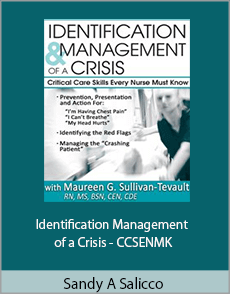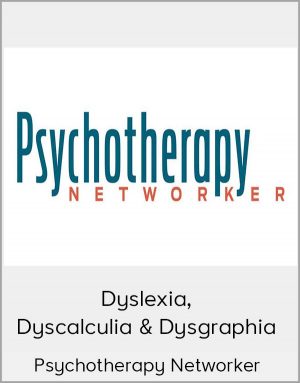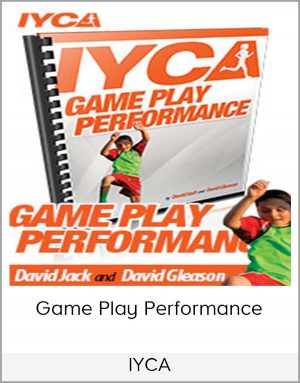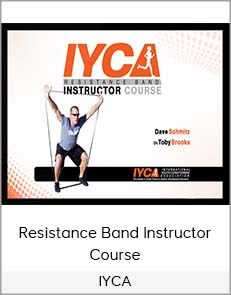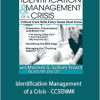Sandy A Salicco – Identification Management of a Crisis – CCSENMK
$45.00$219.99 (-80%)
The patients in our hospitals are sicker than ever before. It is not uncommon to find patients on regular medical floors with central lines, chest tubes, pacemakers and AICDs.
Sandy A Salicco – Identification Management of a Crisis – CCSENMK
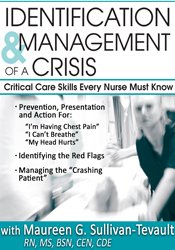
Check it out: Sandy A Salicco – Identification Management of a Crisis – CCSENMK
Description
Mrs. Kelp is admitted to your floor with pneumonia and an exacerbation of COPD. Twenty minutes after admission, she develops worsening dyspnea and hypotension.
Are you prepared to manage her unstable condition?
Do you know what respiratory measures are necessary?
Do you know the best way to manage her hypotension?
The patients in our hospitals are sicker than ever before. It is not uncommon to find patients on regular medical floors with central lines, chest tubes, pacemakers and AICDs. Some nursing homes are accepting patients on ventilators, and patients are now being sent home on vasoactive drips such as dobutamine. Even though acuity levels are higher, you are still caring for many patients and don’t have the luxury of frequent, comprehensive assessments. Therefore, it is important to be able to rapidly assess and implement appropriate interventions. Attend this seminar to sharpen your skills and leave prepared to identify and manage your next patient emergency!
Handouts
Webcast Manual (5.42 MB) 95 Pages Available after Purchase
Outline
IDENTIFYING THE RED FLAGS
- Critical Thinking During a Crisis
- Rapid Assessment Techniques
- ABCD in Less Than 10 Seconds
- Critical Questions to Ask Your Patient
CARDIOVASCULAR
Prevention, Presentation, Action for: “I’m Having Chest Pain”
- Recognizing Arrhythmias
- Stable, Unstable and Lethal
- 12-Lead EKG: Just the Down and Dirty
- Utilizing a Systematic Approach
- Patterns of Ischemia, Injury & Infarct
- Acute Myocardial Infarction: STEMI/NSTEMI
- Key Assessments & Interventions
- tPA Guidelines
- Cath Lab Intervention
- Heart Failure
- Recent Advances in Care
- Medication Management
- Fluid Restriction
RESPIRATORY
Prevention, Presentation, Action for: “I Can’t Breathe”
- Assessment & Intervention
- Anxiety vs. Respiratory Symptoms
- The Patient Who Needs Assistance
- O2, CPAP, BiPAP
- Indications for Intubation
- Positive Pressure Ventilation
- Respiratory Syndromes
- Spontaneous Pneumothorax
- Chest Tube Management
- COPD
- Presentation: Why the Pursed Lips & Barrel Chest
- PROACTIVE not Reactive Interventions
- Respiratory Failure
- Ventilator Settings Every Nurse Must Know
- Spontaneous Pneumothorax
NEUROLOGICAL
Prevention, Presentation and Action for: “My Head Hurts!”
- Elevated Intracranial Pressure
- Clues When you Don’t have a Monitor
- Ischemic vs. Hemorrhagic Stroke
- Inclusion/Exclusion for tPA
- Essential Assessments post-tPA
MANAGING THE DECOMPENSATING PATIENT
Prevention, Presentation and Action for: “The Crashing Patient”
- Anaphylaxis
- Sepsis
- Shock
- Considerations for Transport
- Activating the Rapid Response Team
Faculty

Sandy A Salicco, RN, MSN, CCR N, LHRM, TNCC
Clinical Specialist for Surgical Services
Tampa Community Hospotal
Sandy A. Salicco, RN, MSN, CCR N, LHRM, TNCC, is a clinical specialist for surgical services (including OR, Pre-op, PACU and Endoscopy), and interventional radiology at a tertiary care facility. She has been a nurse for over 35 years, and has been an educator for many of these years, both formally and informally. She has maintained her CCRN for over 25 years, and stays current as a Licensed Healthcare Risk Manager. She has had experience in critical care, including ICU, CCU, PACU, ED, PICU, and high-risk OB, and has a special passion for cardiac arrhythmias. She taught many cardiac rhythm and EKG classes. Having completed the Clinical Ethics for Practitioners Program many years ago, she tries to stay involved in both nursing ethics and bioethics. Sandy has spoken nationally at many conferences on such topics as rapid response, subtle changes in the patient’s condition, aggressive management of the unstable med-surg patient, documentation, expanding in-service education, advanced directives, and multicultural awareness in end-of-life decisions, just to name a few. She thoroughly enjoys teaching and likes to instill a little humor in her presentations, but she mostly enjoys the healthcare professionals she gets to meet along the way!




